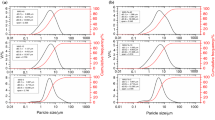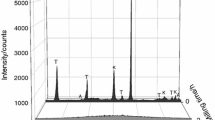Abstract
Since cordierite, 2MgO·2Al2O3·5SiO2 (MAS), is a very useful high-temperature ceramic material, it is important to decrease its sintering temperature. In order to accelerate the process of sintering, 5.00 mass% MoO3 was added to the starting mixtures. The mechanical activation of the starting mixtures was performed in a high-energy ball mill in time intervals from 0 to 160 min. After the activation, starting mixtures were sintered at 1300 °C for 2 h. In order to determine the impact of mechanical activation on particle size distribution and powders morphology, the mechanically treated powders were characterized by a laser light-scattering particle size analyzer and scanning electron microscopy. The phase composition of the starting mixtures and sintered samples was analyzed by the X-ray diffraction method. In order to determine temperature intervals of chemical reactions and phase transitions, differential thermal analyses (DTA) and thermo-gravimetric analysis were used. Kissinger’s equation was employed to calculate apparent activation energies of various processes that occur within the system during heating. Based on the obtained DTA results, it was established that mechanical activation along with MoO3 additive has influence on sintering temperature which was decreased for more than 100 °C, comparing to the literature data.







Similar content being viewed by others
References
Marzieh K, Touradj E. Effect of mechanical activation and microwave sintering on crystallization and mechanical strength of cordierite nanograins. Ceram Int. 2015;41:2342–7.
Jankovic-Castvan I, Lazarevic S, Tanaskovic D, Orlovic A, Petrovic R, Dj Janackovic. Phase transformation in cordierite gel synthesized by non-hydrolitic Sol–Gel route. Ceram Int. 2007;33:1263–8.
Drummond CH. Glass formation and crystallization in high temperature glass ceramics and Si3N4. J Non-Cryst Solids. 1990;123:114–28.
Warsworth I, Stevens R. The influence of whisker dimensions on the mechanical properties of cordierite/SiC whisker composites. J Eur Ceram Soc. 1992;9:153–63.
Pinero M, Atik M, Zarzycki J. Cordierite-ZrO2 and cordierite-Al2O3 composites obtained by sonocatalytic methods. J Non-Cryst Solids. 1992;147–148:523–31.
Kervadec D, Coster M, Chermant JL. Morphology of magnesium lithium aluminum silicate matrix reinforced by silicon carbide fibers during high temperature tests. Mater Res Bull. 1992;27:967–74.
Zobina LD, Semchenko GD. Belik YaG. Synthesis of cordierite and the technology of cordierite-containing articles. Refractories. 1983;24:72–5.
Fotoohi B, Blackburn S. Effects of mechanochemical processing and doping of functional oxides on phase development in synthesis of cordierite. J Eur Ceram Soc. 2012;32:2267–72.
Luo L, Zhou H, Xu C. Microstructural development on sol–gel derived cordierite ceramics doped B2O3 and P2O5. Mater Sci Eng B. 2003;99:348–51.
Parcianello G, Bernardo E, Colombo P. Cordierite ceramics from silicone resins containing nano-sized oxide particle fillers. Ceram Int. 2013;39:8893–9.
Neto JBR, Moreno R. Effect of mechanical activation on the rheology and casting performance of kaolin/talc/alumina suspensions for manufacturing dense cordierite bodies. Appl Clay Sci. 2008;38:209–18.
Tamborenea S, Mazzoni AD, Aglietti EF. Mechanochemical activation of minerals on the cordierite synthesis. Thermochim Acta. 2004;411:219–24.
Koc S, Toplan N, Yildiz K, Toplan HO. Effects of mechanical activation on the non-isothermal kinetics of mullite formation from kaolinite. J Therm Anal Calorim. 2011;103:791–6.
Farhanchi M, Neysari M, Barenji RV, Heidarzadeh A, Mousavian RT. Mechanical activation process for self-propagation high temperature synthesis of ceramic-based composites. J Therm Anal Calorim. 2015;122:123–33.
Obradović N, Đorđević N, Peleš A, Filipović S, Mitrić M, Pavlović VB. The influence of compaction pressure on the density and electrical properties of cordierite-based ceramics. Sci Sinter. 2015;47:15–22.
Yalamac E, Akkurt S. Additive and intensive grinding effects on the synthesis of cordierite. Ceram Int. 2006;32:825–32.
Tucker MG, Keene DA, Dove MT. A detailed structural characterization of quartz on heating through the α–β phase transition. Mineral Mag. 2001;65:489–507.
De Aza S, Monteros E. Mecanismo de la formación de cordierita en cuerpos cerámicos. Bol Soc Esp Ceram Vidr. 1972;11:315–21.
Kirsever D, Karakus N, Toplan N, Toplan HO. The cordierite formation in mechanically activated talc-kaoline-alumina-basalt-quartz ceramic system. Acta Phys Polonica A. 2014;127:1042–4.
Chychko A, Teng L, Seetharaman S. MoO3 evaporation studies from binary systems towards choice of Mo precursors in EAF. Steel Res Int. 2010;81:783–91.
Kissinger HE. Reaction kinetics in differential thermal analysis. Anal Chem. 1957;29:1702–6.
Obradović N, Đorđević N, Filipović S, Nikolić N, Kosanović D, Mitrić M, Marković S, Pavlović V. Influence of mechanical activation on the sintering of cordierite ceramics in the presence of Bi2O3 as a functional aditive. Powder Technol. 2012;218:157–61.
Acknowledgements
This research was performed within the project 172057, funded by the Ministry for education, science and research development of the Republic of Serbia and project F-7/II funded by the Serbian Academy of Sciences and Arts.
Author information
Authors and Affiliations
Corresponding author
Rights and permissions
About this article
Cite this article
Obradović, N., Đorđević, N., Filipović, S. et al. Reaction kinetics of mechanically activated cordierite-based ceramics studied via DTA. J Therm Anal Calorim 124, 667–673 (2016). https://doi.org/10.1007/s10973-015-5132-9
Received:
Accepted:
Published:
Issue Date:
DOI: https://doi.org/10.1007/s10973-015-5132-9




